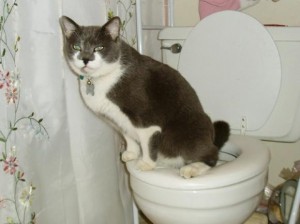Why Flushing Cat Poop Down Your Toilet Is Bad - Suggestions for Proper Handling
Why Flushing Cat Poop Down Your Toilet Is Bad - Suggestions for Proper Handling
Blog Article
Just about every person may have their private perception when it comes to How to Dispose of Cat Poop and Litter Without Plastic Bags.

Intro
As feline proprietors, it's essential to bear in mind how we deal with our feline good friends' waste. While it might seem practical to flush pet cat poop down the bathroom, this method can have harmful repercussions for both the setting and human health and wellness.
Environmental Impact
Flushing feline poop introduces harmful microorganisms and bloodsuckers into the water supply, positioning a considerable risk to marine communities. These pollutants can adversely impact marine life and concession water high quality.
Wellness Risks
In addition to ecological problems, flushing pet cat waste can likewise present health risks to people. Pet cat feces might have Toxoplasma gondii, a parasite that can trigger toxoplasmosis-- a possibly serious illness, specifically for expecting women and people with weakened immune systems.
Alternatives to Flushing
Fortunately, there are much safer and a lot more accountable methods to get rid of feline poop. Consider the complying with options:
1. Scoop and Dispose in Trash
The most typical method of throwing away cat poop is to scoop it right into an eco-friendly bag and toss it in the garbage. Make sure to utilize a dedicated clutter inside story and get rid of the waste without delay.
2. Use Biodegradable Litter
Opt for eco-friendly pet cat trash made from materials such as corn or wheat. These trashes are eco-friendly and can be securely dealt with in the garbage.
3. Bury in the Yard
If you have a lawn, take into consideration burying cat waste in a designated location far from veggie yards and water sources. Be sure to dig deep sufficient to prevent contamination of groundwater.
4. Install a Pet Waste Disposal System
Invest in a pet dog garbage disposal system especially developed for cat waste. These systems make use of enzymes to break down the waste, lowering smell and environmental impact.
Final thought
Responsible animal possession extends past offering food and sanctuary-- it additionally involves proper waste management. By refraining from purging feline poop down the commode and opting for different disposal approaches, we can reduce our environmental impact and secure human health and wellness.
Why You Should NEVER Flush Cat Poop (and/or Litter) Down Your Toilet
The Problem with Litter
The main function of litter is to solidify and adhere to your cat’s waste. While this makes litter excellent for collecting cat poop and urine, it’s also the exact property that makes it a nightmare when flushed down the toilet.
Cat litter can and will clog pipes. There is non-clumping litter, but it’s still quite heavy and can build up in pipes. This is true even of supposed “flushable litter.”
The problems only compound when the litter is already clumped into cat waste. Toilet paper is among the more flushable things, and even too much of that will clog a toilet.
The Problem with Cat Poop
Sewers and septic systems are designed with human waste in mind. The microbes that help break down human waste don’t work on cat waste. Additionally, cat poop plays host to the parasite Toxoplasma gondii.
When flushed, this parasite can enter the environment in places it was never meant to, posing a risk to pregnant women, their unborn children, and other people with compromised immune systems. While it might not seem possible, flushing cat poop can indeed introduce this parasite to the public water supply.
These reasons are why, even if you’ve trained your cat to go on the toilet and flush, which is possible, it’s still not a good idea. Also, pregnant women and the immunocompromised shouldn’t change litter, either.
How to Handle Litter
The best way to handle litter is to simply put it in a plastic bag and place it in the trash. Avoiding environmental risks and possible plumbing damage is worth the extra effort.
You can also invest in devices that seal away your cat’s waste in a separate compartment, so you don’t have to change the litter nearly as often. They’re also safer for pet owners because they limit the possibility of Toxoplasma gondii exposure.
Disposing of litter the old-fashioned way will ensure you won’t have to worry about any issues that flushing the waste can potentially cause.
Take Care of Clogged Pipes with Stephens Plumbing, Heating & Air Conditioning
The reasons you should never flush cat poop down your toilet are numerous, but sometimes the inevitable happens despite your best efforts.
Stephens Plumbing, Heating & Air Conditioning is ready to help if you’re experiencing litter-blocked plumbing. Whether you need us in an emergency or want to schedule regular maintenance, we’re here for you.
https://www.stephensplumbing.net/bathroom-plumbing/never-flush-cat-poop-down-your-toilet/

I ran across that review on Don’t flush cat feces down the toilet while doing research the web. Are you aware of somebody else who is occupied with the subject? Please feel free to share it. Thank you so much for taking the time to read it.
Schedule Estimate Report this page